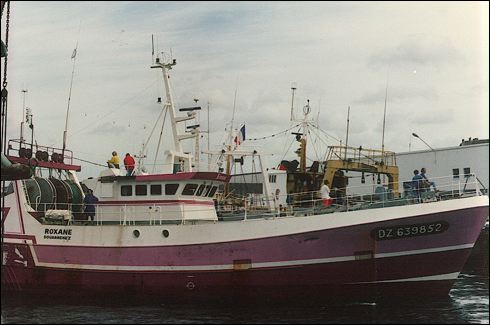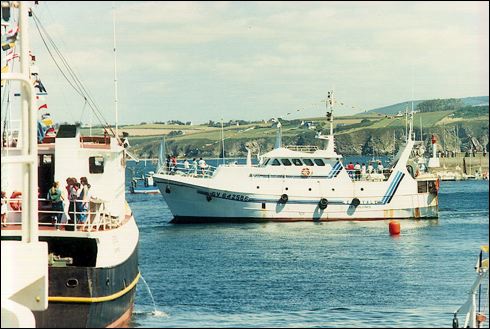PUNT FOR SALE
£750 ono
Popular and well know hull from Seaking. Currently in St Ives.
Length 4.42m x breadth 1.8m x depth 0.75m
Call Alex on 07934035148
Welcome to Through the Gaps, the UK fishing industry's most comprehensive information and image resource. Newlyn is England's largest fish market and where over 50 species are regularly landed from handline, trawl, net, ring net and pot vessels including #MSC Certified #Hake, #Cornish Sardine, handlined bass, pollack and mackerel. Art work, graphics and digital fishing industry images available from stock or on commission.
 |
| French regulations restricted these boats to a maximum of 15 days at sea - the boats all worked by rotating the crew with an extra hand ashore - that way each crew had two lots of three weeks off in a year - generally the boat was in port for two nights only before sailing again. |
 |
| 23m Roxanne in Guilvinec |
 |
| Le Royale in Douarnenez |
"As a fisheries researcher, the ‘Brexit’ referendum on the UK’s membership back in June unexpectedly thrust fishing policy to the front of the political agenda. This was an unusual time for fisheries research, and it was accompanied by a flurry of claims that were widely reported without much scrutiny.
During the referendum campaign, the two claims I heard most often were: 1) that there are foreign vessels in British waters stealing our fish, and 2) that the fishing industry has all but vanished from many coastal communities, leaving behind an economic and cultural vacuum. While it’s understandable to draw a connection between the two claims – and there is some truth behind each claim – it would be a mistake to do so.
The first claim on foreign vessels in British waters has described effectively by other researchers on this blog and elsewhere. Between historic access rights, the division of quota to countries through relative stability, reciprocal access, mobile stocks and foreign investment in the UK fleet, the factors behind foreign vessels are complex, but united in the message that there are good and sensible reasons for why you might see a Dutch or Spanish vessel fishing off the UK coast or docked in port.
The second claim, that fishing activity has declined in many UK ports, has received less attention, and it is unquestionable that many people rooted in coastal communities have observed this decline first-hand during their lifetime. In 1973, when the UK ascended to the EU there were 22,000 fishers. Today, that figure is 12,000. That a decline in port activity is occurring is indisputable, and as fishing policy is EU jurisdiction, it’s easy to understand why all fingers point to Brussels.Unfortunately, few people remember coastal communities before EU ascension. Going back to the first industry records in 1938 show that there were 48,000 fishers at the time, so the EU clearly didn’t invent employment decline. Historic data also shows that overfishing was rampant for much of the twentieth century around the UK and that declining stocks were already leading to a decline in landings before the EU’s Common Fisheries Policy was in effect.
Major North Atlantic fleets:
Country 2000 2014 Decrease %Decrease Norway 13017 6128 6889 52.9% Spain 16685 9632 7053 42.3% Belgium 129 79 50 38.8% Holland 1101 831 270 24.5% France 8229 7069 1160 14.1% UK 7440 6409 1031 13.9%
Like many industries, the fishing sector has undergone technological transformation with capital replacing labour at sea and vessels growing in size while decreasing in number. This general transformation of the industry is clear not only if you look at the UK industry over time, but also if you compare the UK to other countries. For all the talk about foreign vessels pillaging UK waters, the number of Spanish, Dutch, Belgian, French fishers (or whoever the villain of the day is) has declined at a similar rate of about 2% a year. Iceland and Norway, regional neighbours that manage their fisheries outside of the EU, have also seen similar declines.This perspective offered through a longer historical and wider geographical focus isn’t to dismiss the issue of declining fishing activity in ports. Coastal communities in the UK do face more economic hardship than the rest of the UK and the cultural impact of a disappearing port is undeniable. Yet the diagnosis of the problem affects the prescription.
A push to raise fishing quotas, ditch environmental regulations, or construct new aquatic borders will not protect employment in fisheries – at least not for very long. Instead, changes to how fishing access is allocated and ensuring the representation of small-scale fishers in industry organisations could go a long way to meeting the government’s objective to rebalance fishing activity to support the small-scale fleet. The trend in fisheries ownership leaving coastal communities should also be addressed – we need a system where fishers and local communities have really taken back control of their livelihood. Some of these issues were discussed in the recent series of cfooduw blogs on catch shares.
How Brexit will pan out is unclear. Right now, the various trade-offs to negotiate, such as access to waters versus access to markets, are beginning to emerge – although the EU may not be keen on negotiating a bespoke deal at all. It has even been suggested that major reforms to the UK-EU relationship are unlikely to take place for at least a decade. Yet, as many of the changes previously mentioned are the result of national policy, there is no need to wait on the outcomes of Brexit. Actions can be taken today that use the current focus on fisheries policy to bring sustainable employment to coastal communities."